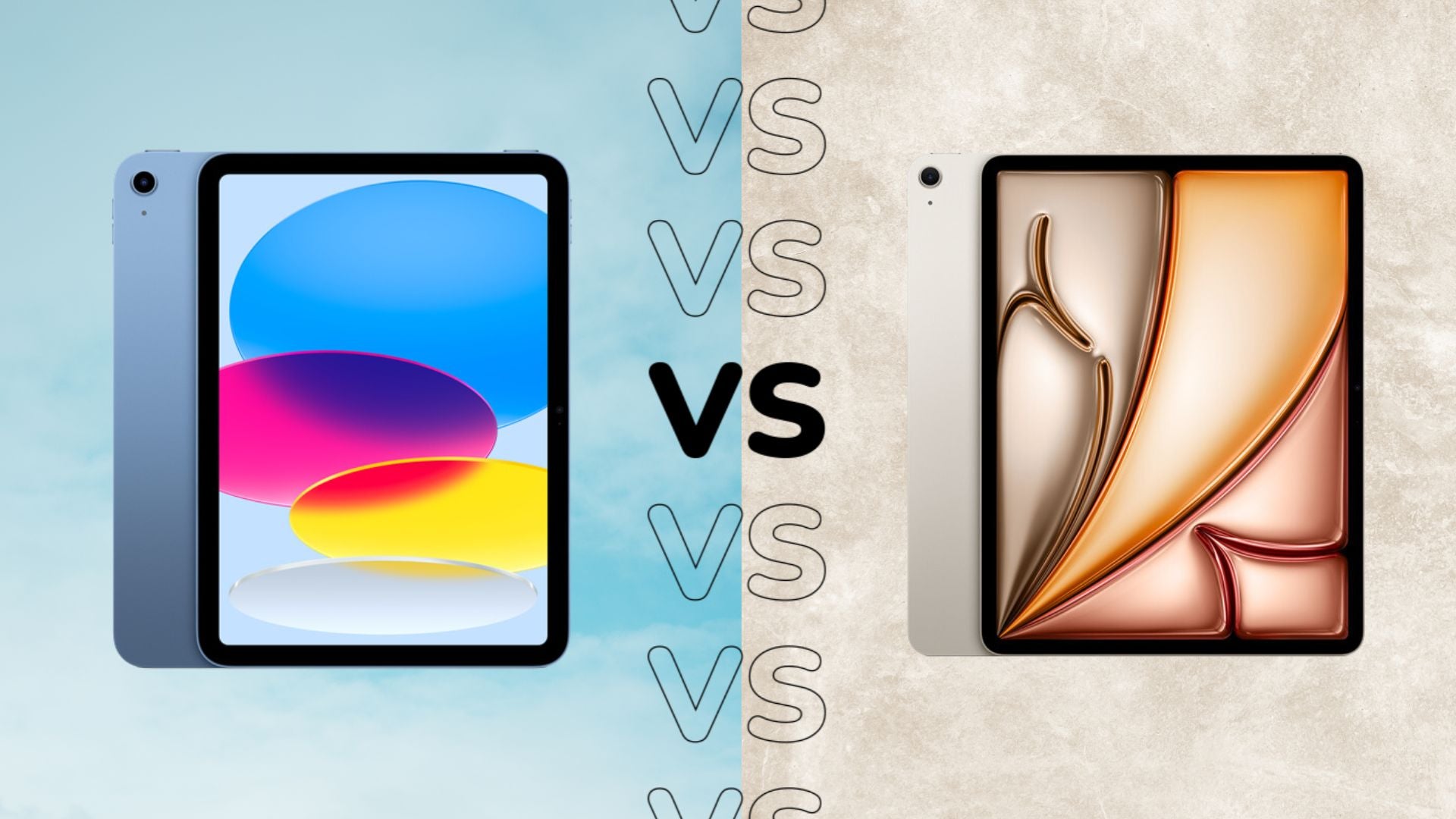Apple‘s iPad collection is divided into four product lines, but it’s not always clear how they differ.
The standard iPad and iPad Air represent two such tablet families, although the ‘Air’ moniker may be confusing to those without a deep knowledge of Apple products.
We’ve created this guide to explain the key differences between the iPad and iPad Air families. We won’t focus on individual products (you can check out our 10th Gen iPad vs iPad Air 2024 guide for that) but on the ranges as a whole.
We’ve tested all the latest models in the iPad and iPad Air families (except the new Air 6, for now!), so we’re well-equipped to provide you with all the buying advice needed to give you the best value for money. And if you need more help, be sure to visit our Best iPad and Best Tablet guides for even more options.

Price
The first thing to note is that the iPad Air is generally more expensive than the base iPad, ignoring used and refurbished models.
Apple’s entry-level iPad has acted as an option for those who need a cheap iPad experience for years, while the more specific iPad variants (Mini, Air, and Pro) are priced much higher. Although the price has fluctuated and grown in line with inflation, the 10th generation iPad will cost you around £349/$349, down from its initial RRP of £499/$449 in mid-2024.
The iPad Air, on the other hand, has always been a more premium option compared to the basic iPad, with the latest model costing up to £599/$599.
Generally speaking, the iPad is considered the entry-level iPad and the price reflects this, while the iPad Air is positioned as a more powerful and premium option that bridges the gap between regular iPads and the high-end iPad Pro collection.
Design
Design is often a key differentiator between these two tablets, with the word “Air” representing a sleeker, lighter design. The latest iPad Air is 6.1mm thick and 462g, while the iPad (10th generation) is 0.9mm thicker and 15g heavier.
There used to be a bigger difference between the two iPad ranges, but the arrival of the iPad 10 has closed the gap, and therefore complicated things.
Until the iPad 10, the tablet design had changed very little. Although it’s gotten a bit flatter and larger in recent years, all iPads up to the iPad 9 are quite reminiscent of the original iPad with thick bezels and a now obsolete home button.
It has a largely premium build with an aluminum back, but its budget nature is notable in some ways as it lacks a laminated screen which makes touches on the tablet feel hollower than the iPad Air’s laminated screen. It’s also more limited in terms of accessory compatibility, lacking the smart connectors present on most other recent iPad models.
However, the latest generation of iPad confuses things a bit. The 10th-generation tablet features a complete redesign that brings it in line with the iPad Air and iPad mini with slimmer bezels, an angular body, and the introduction of Touch ID inside the side power button.
That said, while the recent iPad 10 looks quite similar to its iPad Air siblings, the majority of the entry-level iPad collection is not, and it’s worth keeping that in mind if design is important to you.
The iPad Air, on the other hand, looks and feels more modern and premium with an angular design reminiscent of the iPad Pro and recent iPhone models. It eliminates the Home button to expand screen real estate with much smaller bezels than the basic tablet, supports Smart Sport Connector for advanced accessory use, and as the name suggests, it’s also quite lightweight.
Performance
With the Apple iPad framed as the entry-level option in Apple’s tablet range, it shouldn’t be too surprising to find that the iPad Air is generally the more powerful of the two with the inclusion of newer chipsets.
Apple’s iPad is largely an entry-level tablet in terms of processing power. While the exact chipset depends on which generation of iPad you choose, generally speaking, it’s usually a year or two behind what you’ll find in more premium iPad models.
Let’s take the iPad 10 as an example; It has the same A14 Bionic as the previous generation iPad Air 4 and iPhone 12, both released two years before the iPad. That means that while it’s still powerful enough to be used in a flagship phone, it’s not the best processing power available right now.
That’s a big difference from the iPad Air, which since its rebirth in 2020 has seen it act as a bridge between Apple’s standard and Pro tablet lines, meandering between casual and professional devices.
That said, the iPad Air’s processing power is typically equal to (or greater than) what’s available in the equivalent flagship iPhone of the time. That means the iPad Air 4 shared the same A14 Bionic chipset as the iPhone 12, both of which appeared in September 2020.
However, the 2022 iPad Air went even further with the inclusion of the Apple M1 chipset, the same as that found in Apple’s range of laptops and desktops, as well as previous versions of Apple’s high-end iPad Pro. It’s a significantly more powerful chip compared to the A14 Bionic inside the base iPad.
That trend continues with the latest iPad Air, which features the same M2 chipset as the 2022 iPad Pro range, making it the second most powerful iPad in Apple’s current collection.
More generally, the iPad Air range is more capable than the entry-level iPad range, although if you opt for a fairly recent iPad you’re unlikely to notice a huge difference in everyday tasks. Where the iPad Air will shine, however, is with more processor-intensive apps like LumaFusion Pro and Procreate and console-level gaming.
Accessory support
As with processing power, the iPad Air has been seen as a bridge between regular iPads and the iPad Pro, and accessory support reflects that.
Instead of supporting the older first-generation Apple Pencil and basic folio keyboard, the latest generations of iPad Air feature support for the second-generation Apple Pencil and the premium Magic Keyboard, while the latter has leaped the Apple Pencil Pro and the second. Next-generation magic keyboard. This makes them a tempting option for those who want a tablet for work and play without having to spend on an iPad Pro.
The basic iPad, on the other hand, has traditionally been more limited in terms of accessory support. This means that only the first-generation Apple Pencil and the most basic Bluetooth keyboard folios will be able to be used. They would still get the job done on a limited budget, but it wasn’t the ideal experience.
However, as with other items, the iPad 10 confuses this a bit. The latest iPad offers support for the second-generation Apple Pencil and even has its own dedicated Magic Keyboard, making the difference in accessories much smaller than before.
Verdict
The standard iPad is the most affordable option, and the iPad Air occupies the mid-range zone in Apple’s tablet family. However, with the latest iPad 10 getting a design update, there’s not much separating the two tablets these days.
The most notable difference can be found in the performance department. The iPad Air is generally much more powerful than the regular iPad, and that’s especially true of the latest generation and its M2 chipset. But you’ll probably only notice that performance difference if you do heavy tasks like video editing—the iPad 10 is fast enough for everyday jobs.
Elsewhere, the iPad Air has an advantage with the addition of a fully laminated screen, support for the second-generation Apple Pencil (and, more recently, the Apple Pencil Pro), and a marginally thin design. If you think those features are worth paying extra money for, then the iPad Air is your tablet of choice. Otherwise, the standard iPad is a fantastic alternative that will save you a good amount of money.
Keynote USA News
For the Latest Apple News. Follow @Keynote USA News on Twitter Or Google News.




